The Dare To Be Different 140 S is a softshell roof top tent that combines space and a low weight with a friendly price. Read the review or watch the videoreview!
- Pack Size: 125 x 143 x 30 cm
- Sleep size: 135 x 234 x 74/106 cm
- Weight: 61 kg (Inc. ladder)
- Price: 1375,00
The Dare To Be Different 140 S is a softshell roof top tent that has been on the market already for quite some time. The tent that I am testing here is the latest 2019 model that has some major improvements from the previous model. What has remained is that the Dare To Be Different is still a tent that combines space and a low weight with a friendly price.
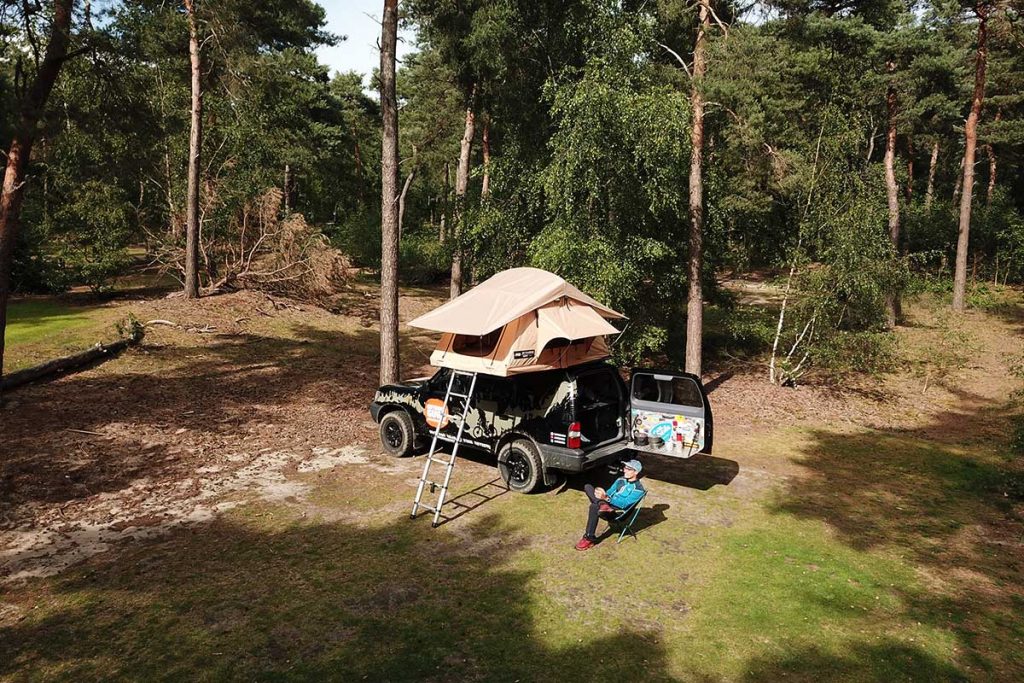
Softshell tent
The Dare To Be Different 140 S is a softshell roof top tent. This means that it looks like a real tent that has been put on to the car roof. The cover to protect the tent when packed while driving or stored is made from a soft material called Bisonyl instead of a hard material like ABS or Polyester. These hard-shell roof top tents look stored like a ski box. Bisonyl is a sturdy material that is also used as cover for truck trailers.
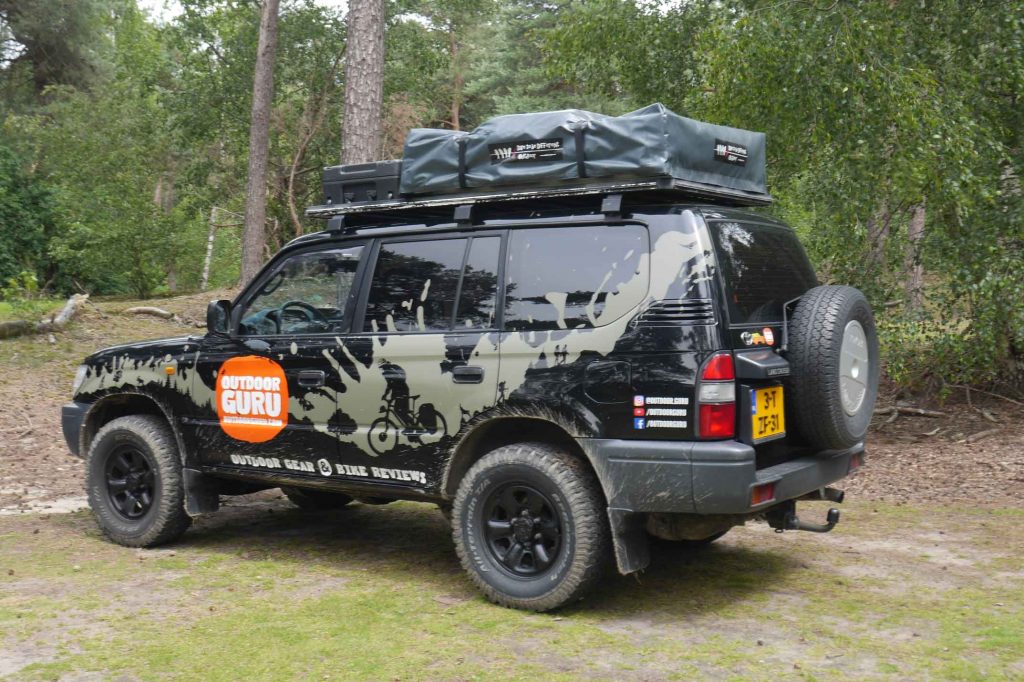
Four sizes
Like the name might reveal: I am reviewing the 140 cm wide Dare To Be Different roof top tent. The S means that it is lengthwise the short version when opened and I have a non-sheltered entrance from the short side. The 140 L is the longer one with a sheltered entrance from underneath the roof top tent. There is also a 180 L and a 220 XL available. The last one sleeps up to 4 persons.
Size and weight
The nice thing about the Dare To Be Different 140 S is that it is a rather small package on the car roof. The packed tent has a rectangular shape and measures 125 cm x 143 x 30 cm. The weight of the complete tent is according to the manufacturer 61 kg including the ladder. This weight should not be a problem to any car roof but always check this with the car manufacturer.
Roofrack
I tested the Dare To Be Different 140 S on top of my 1998 Toyota Landcruiser Prado J95 and the 61 kg weight is not an issue here. I have a Front Runner roofrack on the Toyota and since the width of the roofrack is 125 cm I positioned the Dare To Be Different 140 S so that is unfolds sideways. In this matter the roof top tent is not wider then the roofrack and the car. To mount the tent I used special roof top tent brackets from Front Runner. If you don’t have a roofrack the tent also fits easily on any car roof with two loadbars. To get it on top of the roofrack you need two strong persons.
Base construction
Fitting the Dare To Be Different 140 S is pretty easy. The base of the tent is a strong aluminum sandwich board and underneath this are two aluminum bars. Four bolts slide into the aluminum bars and are connected with the Roof Runner brackets. All I needed was a number 13 wrench to tighten the nuts on the other end of the bolts. If you use load bars it is a bit different since you need to use the ‘U-brackets’ that come standard with the tent.

Tent construction
The main body of the tent is made from a 300 gr/m2 ripstop polyester-cotton (65%/35%) mix fabric with a Polyurethane coating on the inside to make it 100% waterproof. On the outside the fabric has a UV-coating to slow down the deterioration from the sun. The fly is 420 Denier ripstop polyester-oxford fabric that is also PU-coated on the inside and has a UV-protection on the outside. All seams are taped and the application of the taping has been done neatly.
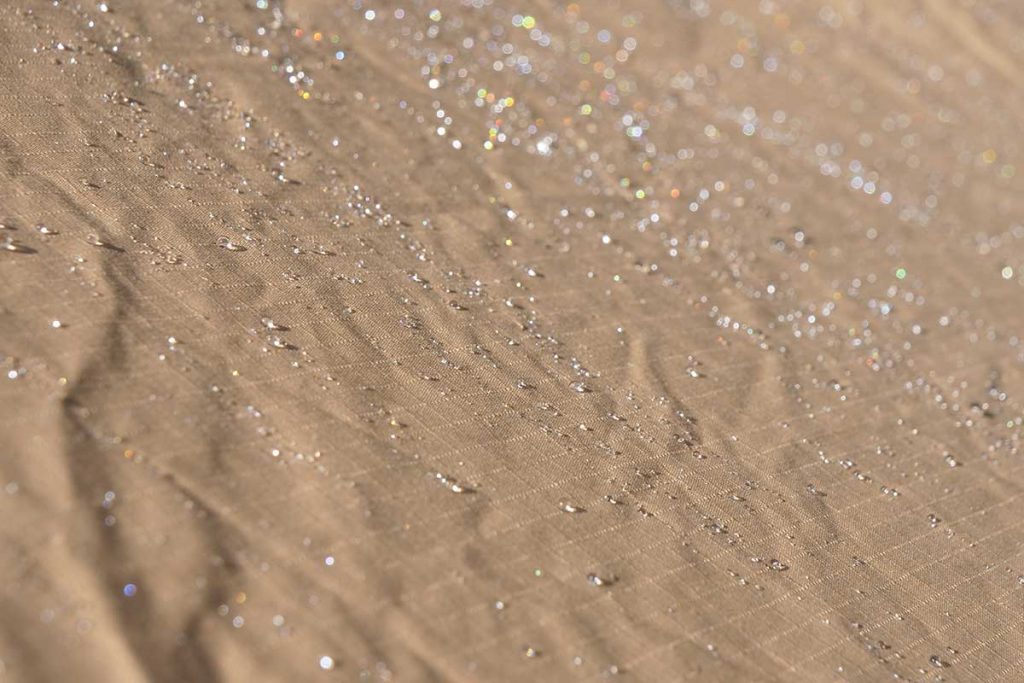
The tent is constructed with six aluminum U-shape poles that form the roof and therefor the tent space. Three U-poles are needed for the main body and three other ones for the fly. New for 2019 is that the inner U-poles have 24 mm tubing instead of the former 16 mm leading to a more windproof tent. New is also that the outer U-poles for the fly are more curved to create a more tent-like look. It also helps rain flowing of the tent more easily.
The poles are connected to a stainless steel triangle that is connected to the base of the tent floor. The construction is solid but I would love to see one small improvement. The connectors and in the same time pivot points between the poles and the steel are plastic ones. For durability reasons I would have chosen metal ones.

Cover
As mentioned above: the Dare To Be Different 140 S cover is made from a sturdy Bisonyl fabric. The cover is quite easy to remove or to attach. It has a beading strip on one side that slides in to an aluminum strip in the tent base. The other three sides have a good long big zipper. Two large belts over the top of the cover should prevent fluttering in the wind.
The cover is waterproof and sturdy enough for hitting the occasional low hanging small branches on a dirt track. With colder weather though, the heavy fabric is quite tuff and not so easy to handle. And with rain… Be careful! The cover is not totally flat and a small puddle stays on top and the first time I got pretty soaked. Taking off the cover takes five minutes, putting it back a bit longer.
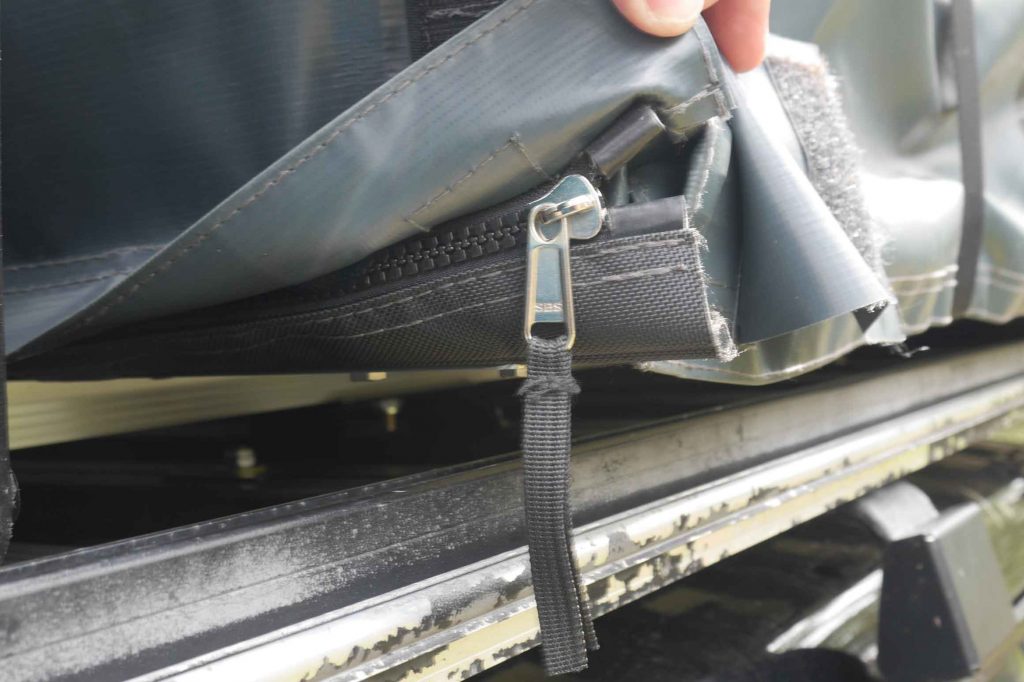
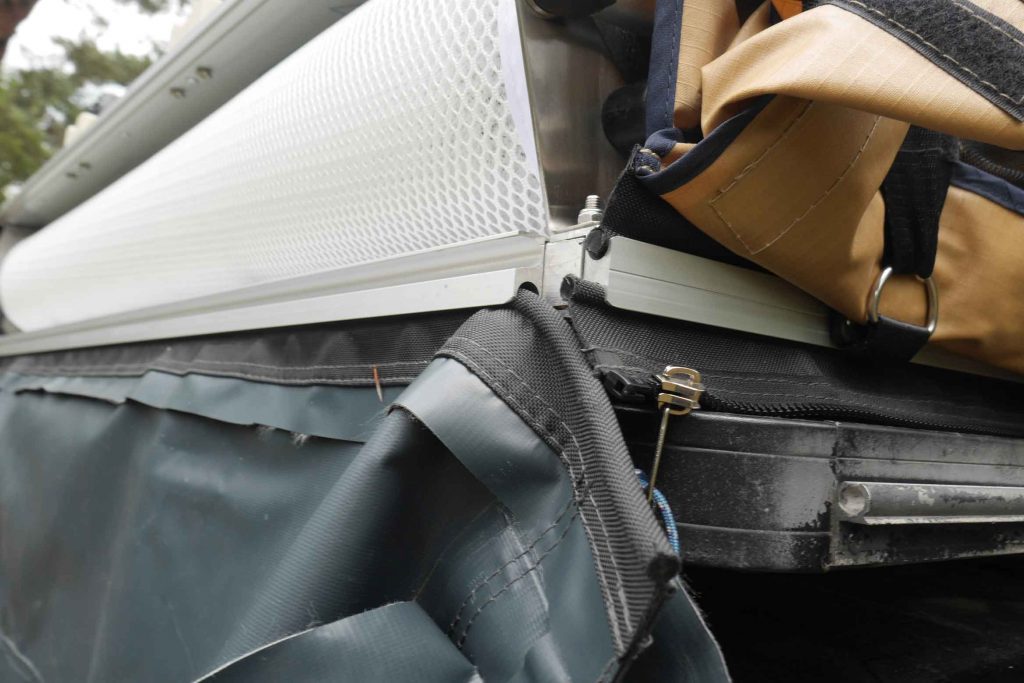
Pitching
After removing the cover the pitching process is pretty easy. Get the ladder extended and use it as a lever to raise the tent. This takes 30 seconds. Than it is a matter of getting the telescopic ladder on the right height. The maximum height for the standard ladder is 230 cm but a 260 cm is available. The last thing I have to do is open the four awnings and place two metal poles per canopy. That’s all folks!
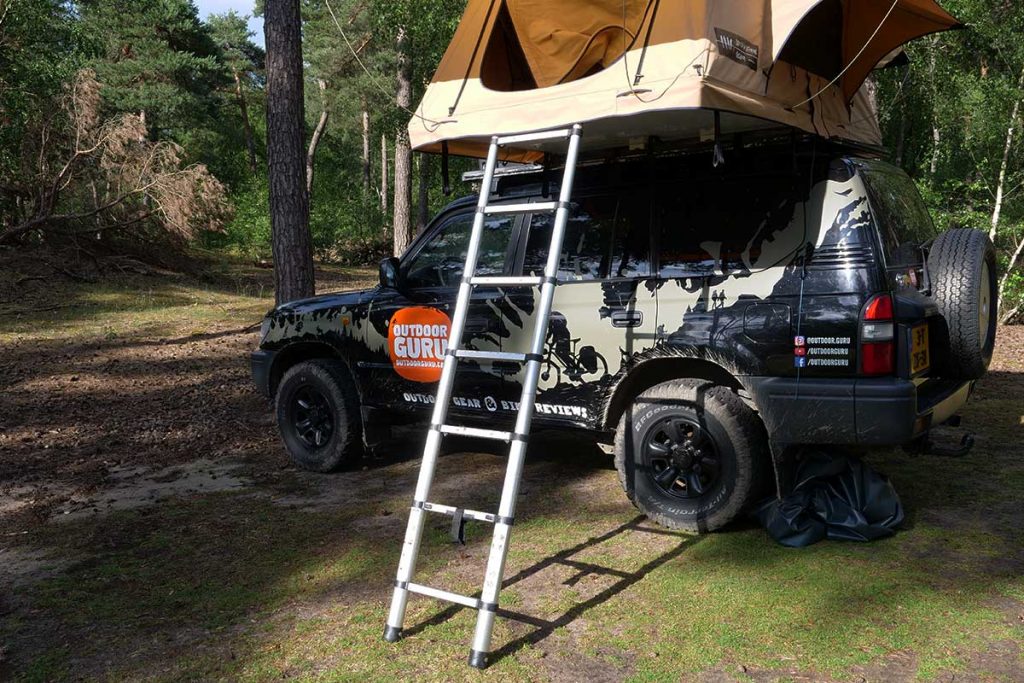
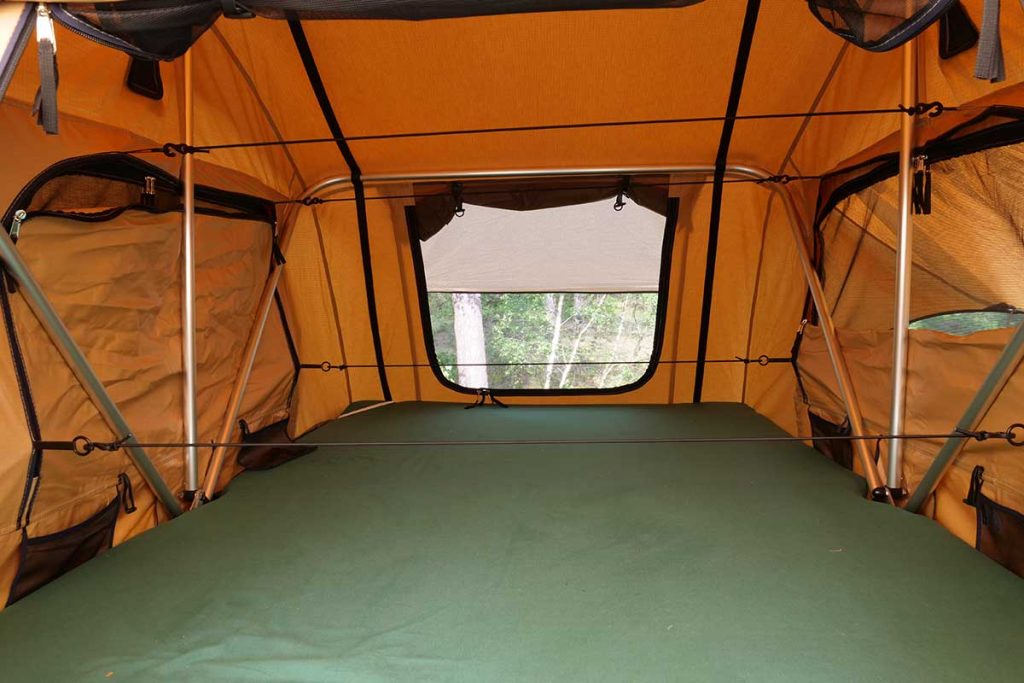
Tentspace
The ladder is of a good quality and getting in the tent feels secure. Since the ladder is fixed to the tentbase there is just one entry. The door has a width of 78 cm and a height of 66 cm. For me as a small person (170 cm) the entry is fine but for real big persons I can image it is a bit on the low side. I noticed also that the awning that is part of the fly is rather low and close to the tent. It makes the entry – or the door – very sheltered but getting in and out I rubbed my back and my head several times into the fabric. And in the morning that can be rather wet due to condensation.
The entry basically consists of two doors: one on the outside made from the poly-cotton fabric and two vertical zippers on the side and a mesh door with a two-way zipper behind it. Opposite the door is a window that is constructed exactly the same. On the sides there are two smaller windows with the same features and awnings. The doors have a reinforcement bead that makes them easy to roll up and store with the toggles provided.
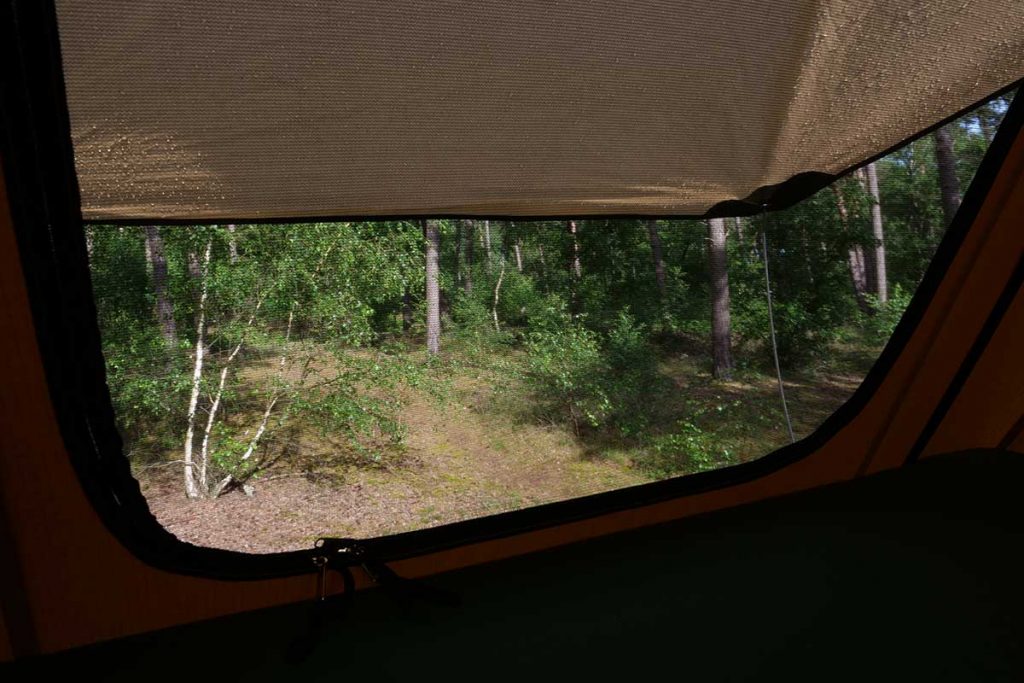
When getting into the tent I like its space. It might be the smallest one but with an interior mattress size of 135 cm width and 234 cm long it is fine for two big adults. The head clearance at the pole at the entrance is 74 cm and in the middle of the Dare To Be Different 140 S it is 106 cm. It is not the highest tent but it is fine if you want to sit upright. In the tent there are four small mesh pockets to store a wallet, a smartphone, a book or glasses. I do miss an attachment point in the roof for a light and a big pocket on the outside for two pair of shoes. The last one will be available shortly!

Sleepingcomfort
The mattress in the Dare To Be Different 140 S is 60 mm thick and I requested to test the tent with the optional ventilating under mattress that is 15 mm thick. The last one has proven to be a very good extra in previous roof top tents I tested. This ventilating mattress – or anti-condensation mattress – is made from a 3D mesh. It helps to get the sweat from the mattress and provides also extra cushioning.
The mattress itself is quite firm and the 3D mesh makes it a comfortable win-win situation. The 3D mesh costs € 150,00. The mattress cover is made from 100% cotton and is removable thanks to a zipper. It feels smooth but I would advice an extra fitted sheet from soft terry cloth on top of it for more comfort. And it is easier to clean. I fitted a 140 cm x 200 cm and that fits easy. Because of the sand color of ‘my’ roof top tent it didn’t get dark inside during the night being in the vicinity of a street lamppost. If you can’t stand the light when trying to sleep try the green or brown/coffee version.
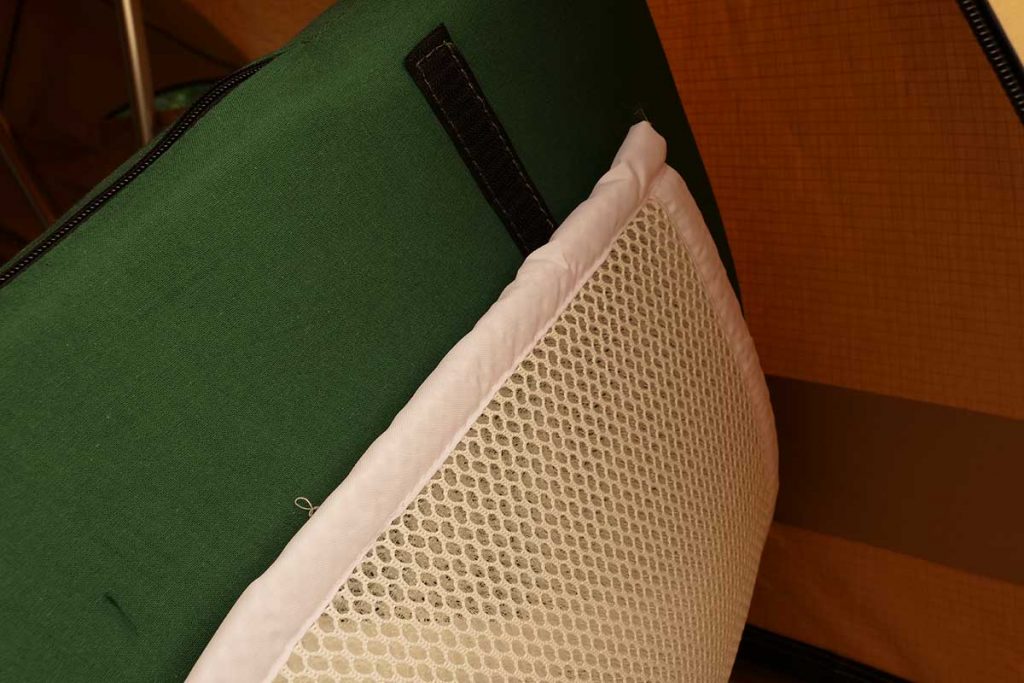
Ventilation and condensation
I have been testing the Dare To Be Different 140 S in springtime and with temperatures ranging from 5 degrees in the Alpes to 24 degrees in The Netherlands. With the windows open and the mesh closed the ventilation is super. But when it was very windy I did have to close everything expect for the opening on the leeward side and than ventilation is still fine. With everything closed the tent still has two-sheltered triangle shaped vents in the top of the roof but they are useless as ventilation. They ere mainly there to release the pressure from the tent when it is taken down.
In the inner tent I hardly noticed any condensation at all. That has off course to do with the fly that covers the tent. Air (wind) can move freely between the two layers. The result is that condensation is limited to the inside of the fly. This construction also helps getting the temperature a bit down when the sun is on the tent.
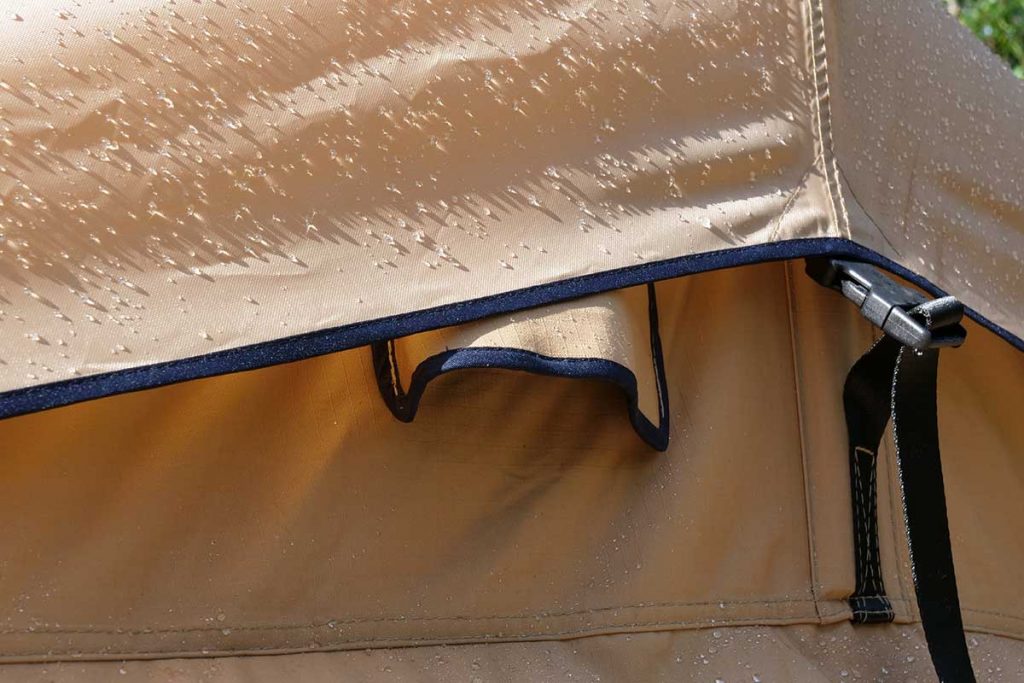
Rain
Since the Dare To Be Different 140 S is a softshell tent it is more affected by wet weather than the hardshell ones. And roof top tents that are sold in Northern Europe should be wind and wetweather proof. I have tested the wind- and waterproofness in real life and with my rain simulator; a garden hose connected to a piece of pipe with nozzles. Well I can be short on the wind- and waterproofness: the Dare To Be Different 140 S is 100% waterproof and also capable to resist quite some wind. Only the canopies have the tendency to start fluttering. The entrance and the windows are well sheltered except from wind and rain that is horizontal. The nice thing about a softshell roof top tent is that when it’s raining…. The sound on the roof is ideal to fall asleep.
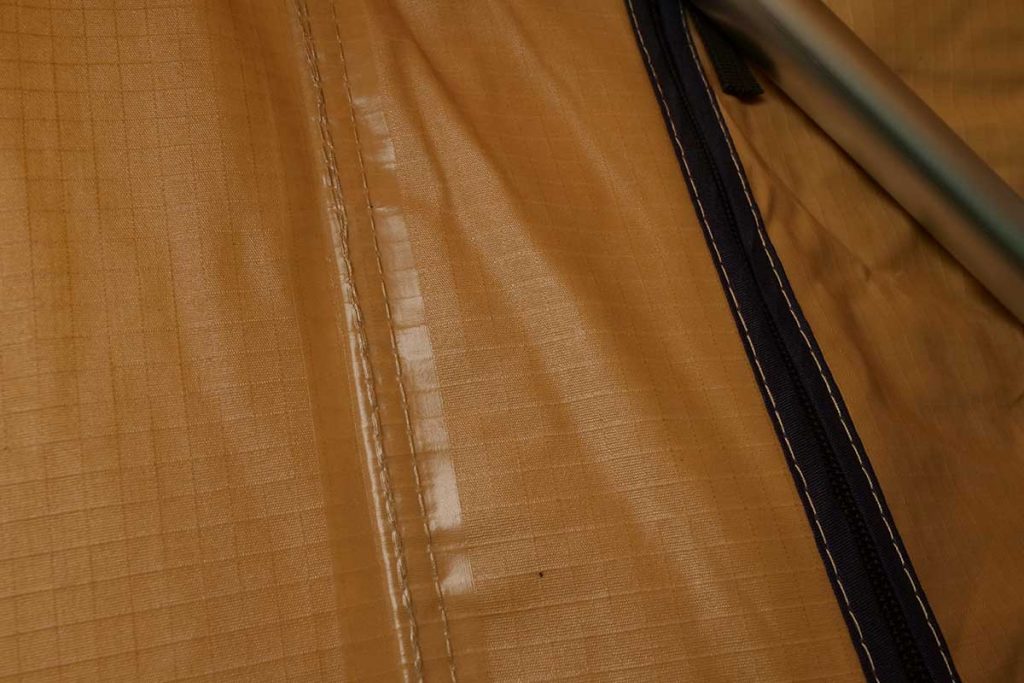
One remark I should make is that the metal poles that keep the awnings upright could be better. I miss a little V in the pole. The V makes that the water dripping from the pole doesn’t reach the tent and so prevents even the possibility of the tentbase getting wet. The envelope in the fabric around the tent base prevents this
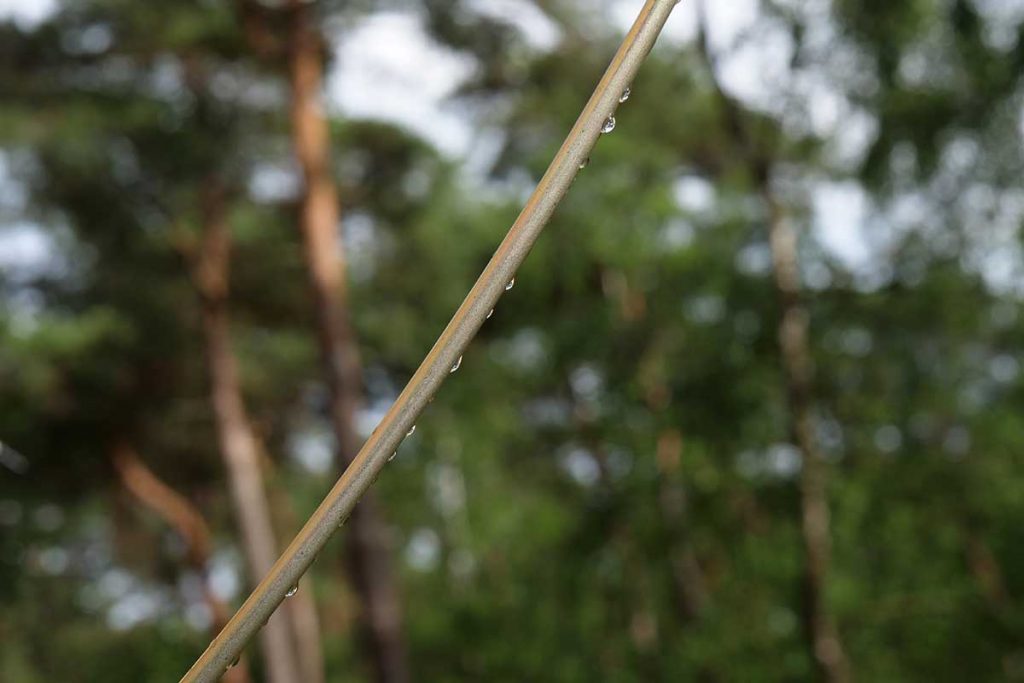
Taking it down
When I am done camping it is time to take the roof top tent down again and store it in its cover. Taking it down is just pitching in reverse order. But…. It takes a good deal longer to do it neatly. This is something I had to get used to. And when it is raining or the tent is wet taking it down is more of a hassle than with the hardshells tents. So if you are looking for a roof top tent and want really easy fast pitching and taking it down…. Maybe reconsider. Packing a wet tent is not a problem for the tent or the interior. The tent can be packed wet several days without a problem for the materials. And the inside….It stays dry when the tent is packed with the door and windows closed.
Built quality
The manufacturing of the Dare To Be Different 140 S has been done neatly. All stitches are accurate and made with a sharp needle so the punctures are tiny. All stiches that are important for the waterproofness are taped and I could not find any flaws. The tent did not get damaged during the review and since I only tested is for three weeks, wear and tear is out of the question. But there is one improvement that I would like so see and two that are necessary.
- As I mentioned above: the connectors between the aluminum tubes and the steel triangle are plastic ones. I would love to see metal ones.
- The poles for the awnings bend to easy and don’t get back in their original shape. Next to that a V in de poles is a must to keep water from reaching the tent base.
- The awning poles rest in a hole in the aluminum tent base. After a while – quite soon – these holes get bigger: the metal poles are harder than de aluminum. The holes would benefit from a metal plate as cover or just a metal bushing.

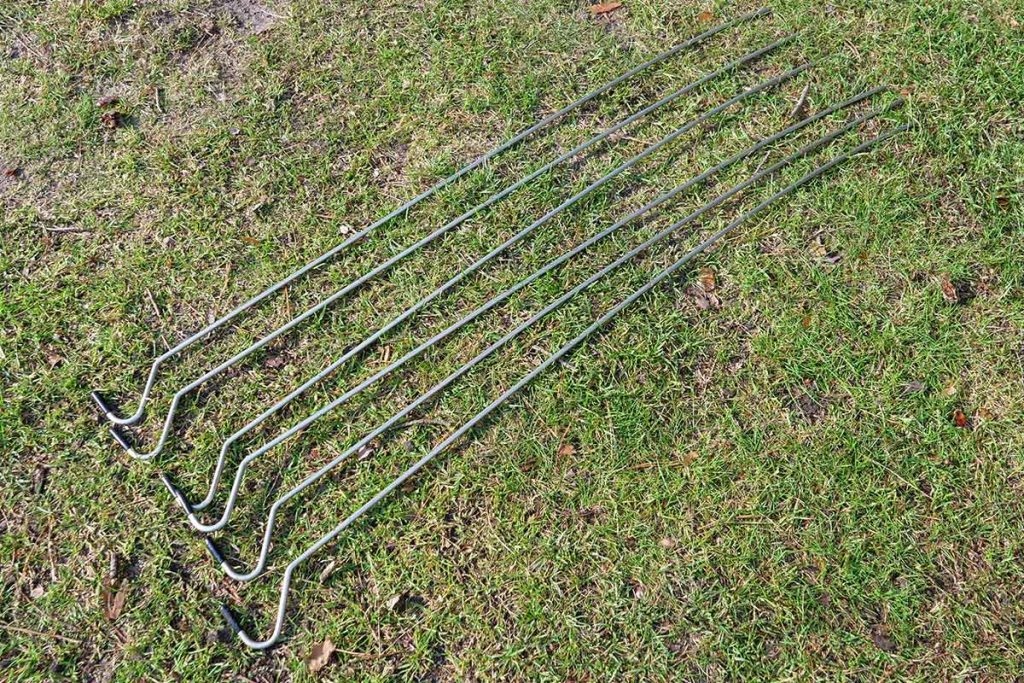
Verdict
The Dare To Be Different 140 S is a real tent. It just sits on top of any car. I like the tentshape, the fabric and the noise it makes when it is raining. The fabric and most materials are well chosen and of a good quality. Likewise is the manufacturing. Pitching is easy but taking it down and putting the cover on takes some time. Just packing to do some shopping is not really a fast process. The ladder is of a good quality and getting in the tent is easy although the entrance is a bit low. The ventilation is super due to the double roof and the large windows and the tent is water- and windproof. The innerspace is spacey for two large adults. The mattress is quite firm and I would advice to buy the extra mesh under mattress. Improvements are stronger poles with a V so rain doesn’t reach the tent base and metal bushing for the poles in that base. I also would like to see some pockets to store shoes. The Dare To Be Different 140 S costs € 1.375,00 and therefor it is not the cheapest softshell roof top tent. But taking the materials and the workmanship into account it is a good price for a decent tent. Overall I rate the Dare To Be Different 140 Sat 8.1/10 points.
Information: www.dtbdoutdoor.eu
More roof top tent reviews here
